Ram 2500 2017 Owner's Manual
Manufacturer: RAM, Model Year: 2017, Model line: 2500, Model: Ram 2500 2017Pages: 734, PDF Size: 7.3 MB
Page 451 of 734

Instrument Cluster Display Messages
When the appropriate conditions exist, a message will
appear in the instrument cluster display. Refer to “Instru-
ment Cluster Display” in “Understanding Your Instrument
Panel” for further information.
An audible chime will be heard whenever a system error
has been detected.
Operation
The indicator lamps 3 through 6 will illuminate to show the
current position of the vehicle. Flashing indicator lamps
will show a position which the system is working to
achieve. When raising or lowering, the flashing indicator
lamp is the position the system is working to achieve.
Pushing the “Up” button once will move the suspension
one position higher from the current position, assuming all
conditions are met (i.e. key in ON/RUN position, engine
running, speed below threshold, etc). The “Up” button can
be pushed multiple times, each push will raise the re-
quested level by one position up to a maximum position of
OR or the highest position allowed based on current
conditions (i.e. vehicle speed, etc).Pushing the “DOWN” button once will move the suspen-
sion one position lower from the current level, assuming all
conditions are met (i.e. key in ON/RUN position, engine
running, doors closed, speed below threshold, etc). The
“DOWN” button can be pushed multiple times, each push
will lower the requested level by one position down to a
minimum of Entry/Exit Mode or the lowest position
allowed based on current conditions (i.e. vehicle speed,
etc.)
Automatic height changes will occur based on vehicle
speed and the current vehicle height. The indicator lamps
and instrument cluster display messages will operate the
same for automatic changes and user requested changes.
•
Off-Road (OR) – Indicator lamps 3, 4, 5 and 6 will be
illuminated when the vehicle is in OR.
• Normal Ride Height (NRH) – Indicator lamps 3, 4 and 5
will be illuminated when the vehicle is in NRH.
• Aero Mode – Indicator lamps 3 and 4 will be illuminated
when the vehicle is in Aero Mode.
5
STARTING AND OPERATING 449
Page 452 of 734
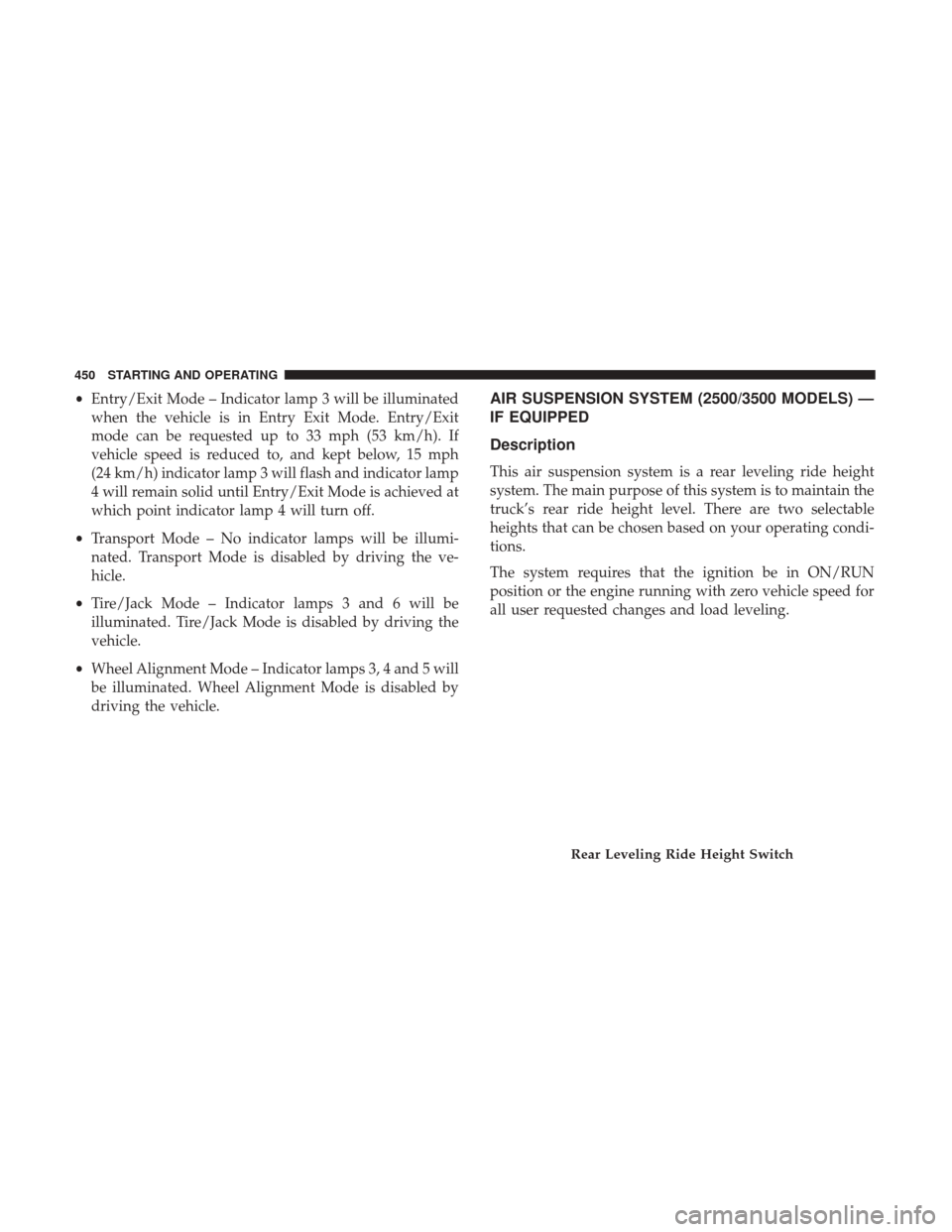
•Entry/Exit Mode – Indicator lamp 3 will be illuminated
when the vehicle is in Entry Exit Mode. Entry/Exit
mode can be requested up to 33 mph (53 km/h). If
vehicle speed is reduced to, and kept below, 15 mph
(24 km/h) indicator lamp 3 will flash and indicator lamp
4 will remain solid until Entry/Exit Mode is achieved at
which point indicator lamp 4 will turn off.
• Transport Mode – No indicator lamps will be illumi-
nated. Transport Mode is disabled by driving the ve-
hicle.
• Tire/Jack Mode – Indicator lamps 3 and 6 will be
illuminated. Tire/Jack Mode is disabled by driving the
vehicle.
• Wheel Alignment Mode – Indicator lamps 3, 4 and 5 will
be illuminated. Wheel Alignment Mode is disabled by
driving the vehicle.AIR SUSPENSION SYSTEM (2500/3500 MODELS) —
IF EQUIPPED
Description
This air suspension system is a rear leveling ride height
system. The main purpose of this system is to maintain the
truck’s rear ride height level. There are two selectable
heights that can be chosen based on your operating condi-
tions.
The system requires that the ignition be in ON/RUN
position or the engine running with zero vehicle speed for
all user requested changes and load leveling.
Rear Leveling Ride Height Switch
450 STARTING AND OPERATING
Page 453 of 734

Normal Ride Height (NRH)– This is the standard position
of the suspension and is meant for normal driving. It will
automatically adjust to maintain the rear ride height as
conditions change.
Alternate Trailer Height (ATH) – Lowers the vehicle
approximately 1 in (25 mm) for a level truck, to be used as
required while trailer towing. It will automatically adjust
to maintain the rear ride height as conditions change.
Trailer Decoupling/Unloading - The air suspension sys-
tem will load level (lower/exhaust only) for up to 10 min-
utes after the vehicle is turned off. This allows for easy
removal of a trailer and/or load from the back of the truck
by maintaining the ride height. After 10 minutes you will
need to turn the ignition to the run position for the air
suspension to maintain ride height. If the air suspension
system is disabled using the settings menu (Tire Jack Mode,
Transport Mode or Alignment Mode) the system will
remain disabled when the vehicle is turned off. Reactivat-
ing the air suspension can be accomplished via the settings
menu or driving the vehicle above 5 mph (8 km/h) for Tire
Jack Mode or Alignment Mode and 16 mph (26 km/h) for
Transport Mode. NOTE:
•
Most 3500 models will not lower to Alternate Trailer
Height (ATH) when unloaded.
• Refer to “Trailer Towing” in “Starting And Operating”
for further information.
Ignition OFF Behavior
For a predetermined amount of time after the ignition is off
the air suspension may adjust to maintain a proper appear-
ance.
WARNING!
The air suspension system uses a high pressure vol-
ume of air to operate the system. To avoid personal
injury or damage to the system, see your authorized
dealer for service.
5
STARTING AND OPERATING 451
Page 454 of 734
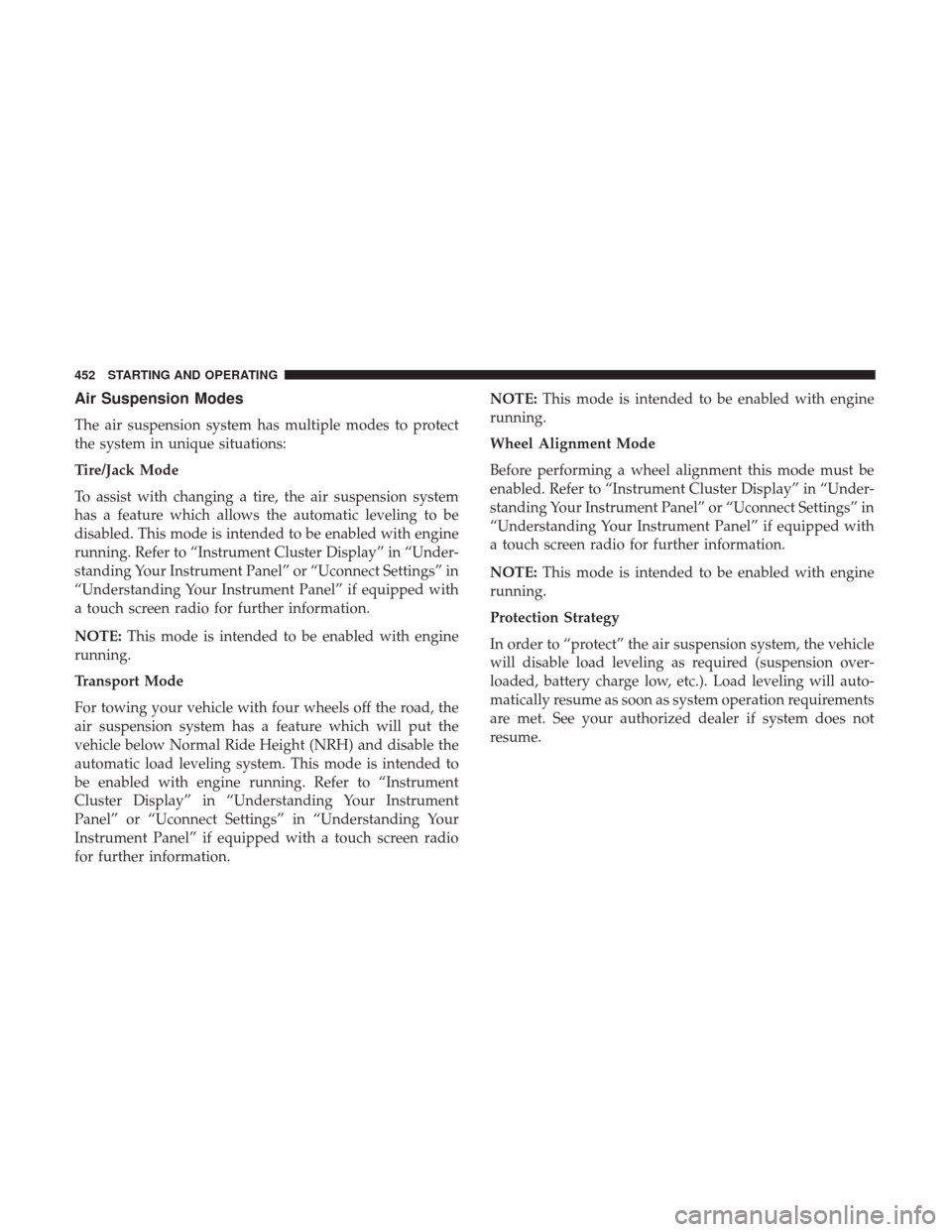
Air Suspension Modes
The air suspension system has multiple modes to protect
the system in unique situations:
Tire/Jack Mode
To assist with changing a tire, the air suspension system
has a feature which allows the automatic leveling to be
disabled. This mode is intended to be enabled with engine
running. Refer to “Instrument Cluster Display” in “Under-
standing Your Instrument Panel” or “Uconnect Settings” in
“Understanding Your Instrument Panel” if equipped with
a touch screen radio for further information.
NOTE:This mode is intended to be enabled with engine
running.
Transport Mode
For towing your vehicle with four wheels off the road, the
air suspension system has a feature which will put the
vehicle below Normal Ride Height (NRH) and disable the
automatic load leveling system. This mode is intended to
be enabled with engine running. Refer to “Instrument
Cluster Display” in “Understanding Your Instrument
Panel” or “Uconnect Settings” in “Understanding Your
Instrument Panel” if equipped with a touch screen radio
for further information. NOTE:
This mode is intended to be enabled with engine
running.
Wheel Alignment Mode
Before performing a wheel alignment this mode must be
enabled. Refer to “Instrument Cluster Display” in “Under-
standing Your Instrument Panel” or “Uconnect Settings” in
“Understanding Your Instrument Panel” if equipped with
a touch screen radio for further information.
NOTE: This mode is intended to be enabled with engine
running.
Protection Strategy
In order to “protect” the air suspension system, the vehicle
will disable load leveling as required (suspension over-
loaded, battery charge low, etc.). Load leveling will auto-
matically resume as soon as system operation requirements
are met. See your authorized dealer if system does not
resume.
452 STARTING AND OPERATING
Page 455 of 734
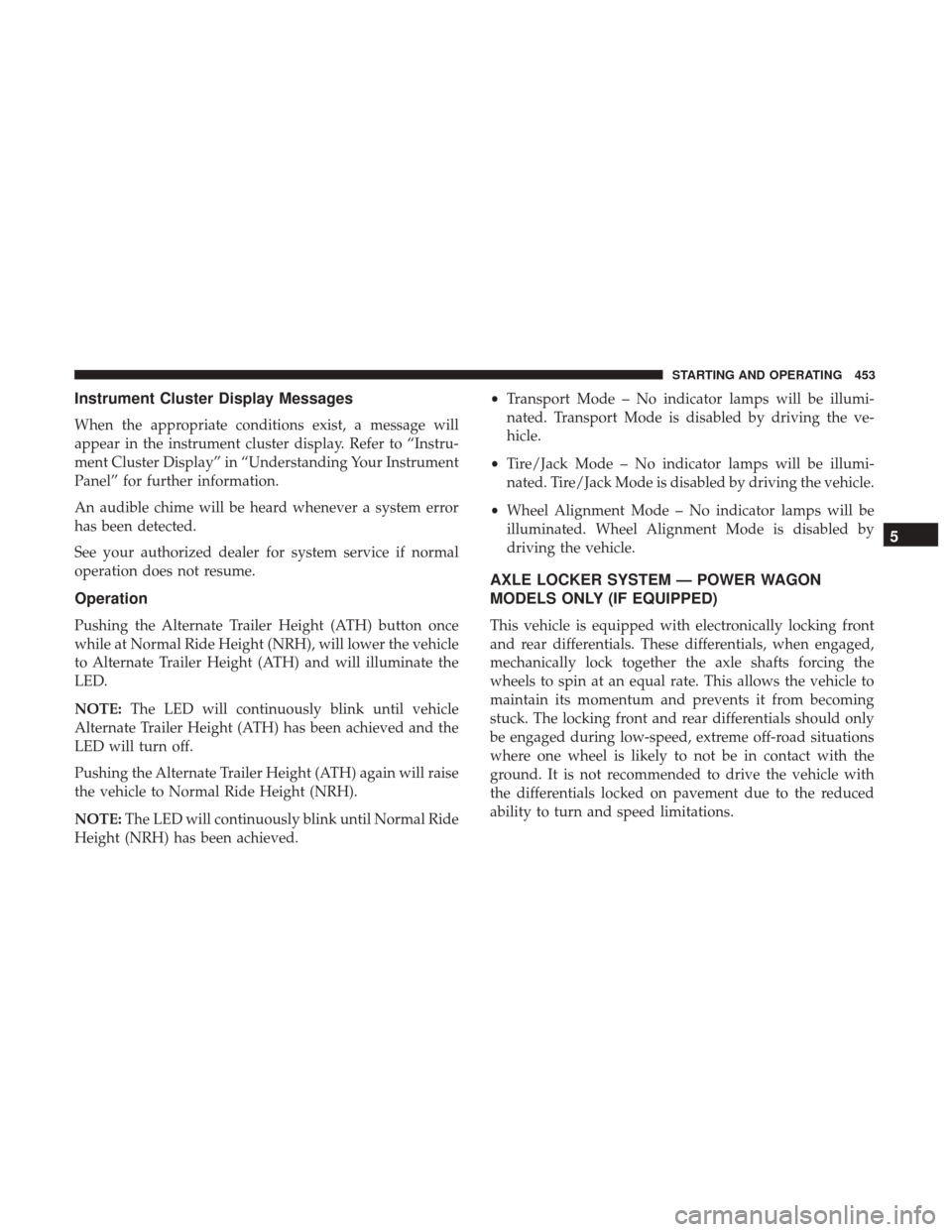
Instrument Cluster Display Messages
When the appropriate conditions exist, a message will
appear in the instrument cluster display. Refer to “Instru-
ment Cluster Display” in “Understanding Your Instrument
Panel” for further information.
An audible chime will be heard whenever a system error
has been detected.
See your authorized dealer for system service if normal
operation does not resume.
Operation
Pushing the Alternate Trailer Height (ATH) button once
while at Normal Ride Height (NRH), will lower the vehicle
to Alternate Trailer Height (ATH) and will illuminate the
LED.
NOTE:The LED will continuously blink until vehicle
Alternate Trailer Height (ATH) has been achieved and the
LED will turn off.
Pushing the Alternate Trailer Height (ATH) again will raise
the vehicle to Normal Ride Height (NRH).
NOTE: The LED will continuously blink until Normal Ride
Height (NRH) has been achieved. •
Transport Mode – No indicator lamps will be illumi-
nated. Transport Mode is disabled by driving the ve-
hicle.
• Tire/Jack Mode – No indicator lamps will be illumi-
nated. Tire/Jack Mode is disabled by driving the vehicle.
• Wheel Alignment Mode – No indicator lamps will be
illuminated. Wheel Alignment Mode is disabled by
driving the vehicle.
AXLE LOCKER SYSTEM — POWER WAGON
MODELS ONLY (IF EQUIPPED)
This vehicle is equipped with electronically locking front
and rear differentials. These differentials, when engaged,
mechanically lock together the axle shafts forcing the
wheels to spin at an equal rate. This allows the vehicle to
maintain its momentum and prevents it from becoming
stuck. The locking front and rear differentials should only
be engaged during low-speed, extreme off-road situations
where one wheel is likely to not be in contact with the
ground. It is not recommended to drive the vehicle with
the differentials locked on pavement due to the reduced
ability to turn and speed limitations.
5
STARTING AND OPERATING 453
Page 456 of 734
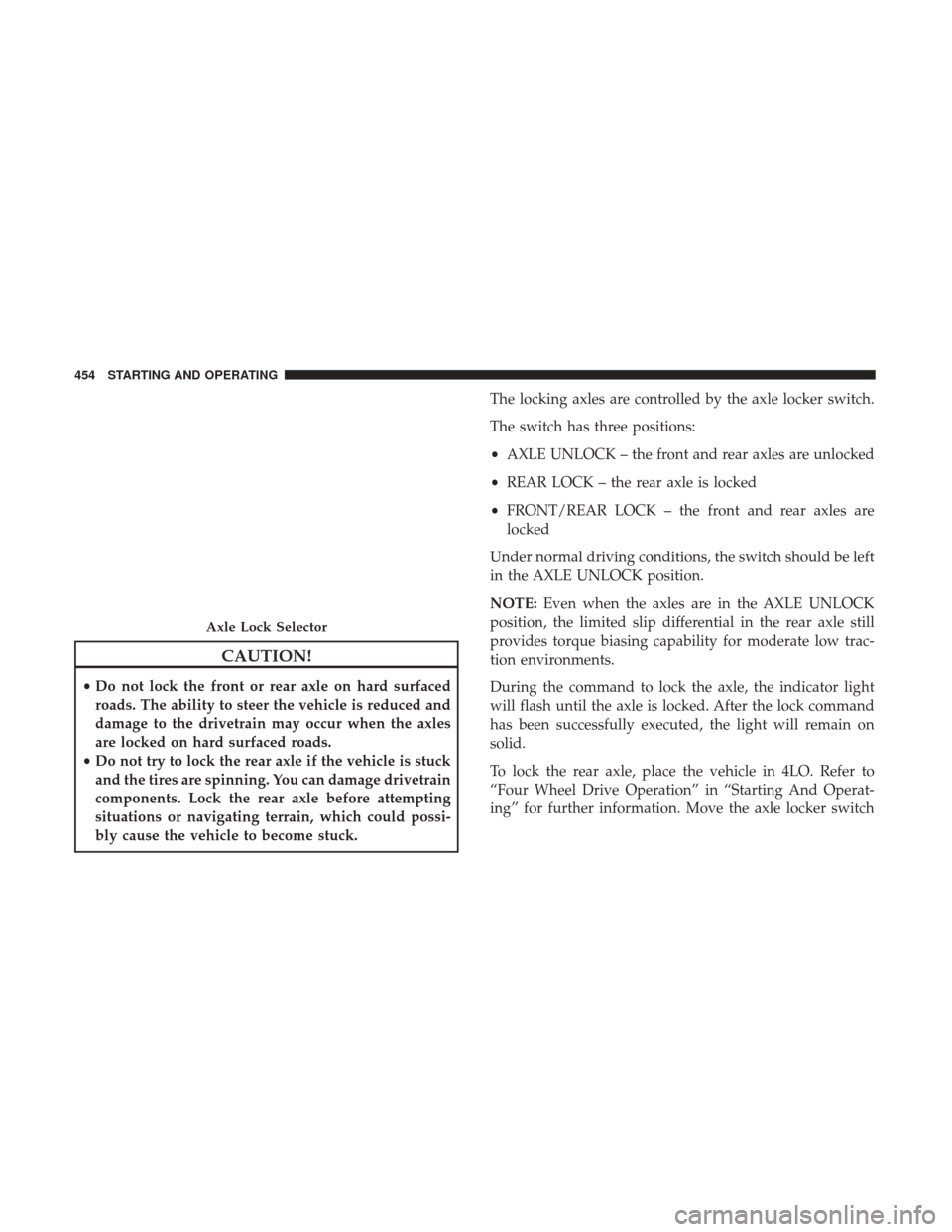
CAUTION!
•Do not lock the front or rear axle on hard surfaced
roads. The ability to steer the vehicle is reduced and
damage to the drivetrain may occur when the axles
are locked on hard surfaced roads.
• Do not try to lock the rear axle if the vehicle is stuck
and the tires are spinning. You can damage drivetrain
components. Lock the rear axle before attempting
situations or navigating terrain, which could possi-
bly cause the vehicle to become stuck. The locking axles are controlled by the axle locker switch.
The switch has three positions:
•
AXLE UNLOCK – the front and rear axles are unlocked
• REAR LOCK – the rear axle is locked
• FRONT/REAR LOCK – the front and rear axles are
locked
Under normal driving conditions, the switch should be left
in the AXLE UNLOCK position.
NOTE: Even when the axles are in the AXLE UNLOCK
position, the limited slip differential in the rear axle still
provides torque biasing capability for moderate low trac-
tion environments.
During the command to lock the axle, the indicator light
will flash until the axle is locked. After the lock command
has been successfully executed, the light will remain on
solid.
To lock the rear axle, place the vehicle in 4LO. Refer to
“Four Wheel Drive Operation” in “Starting And Operat-
ing” for further information. Move the axle locker switch
Axle Lock Selector
454 STARTING AND OPERATING
Page 457 of 734
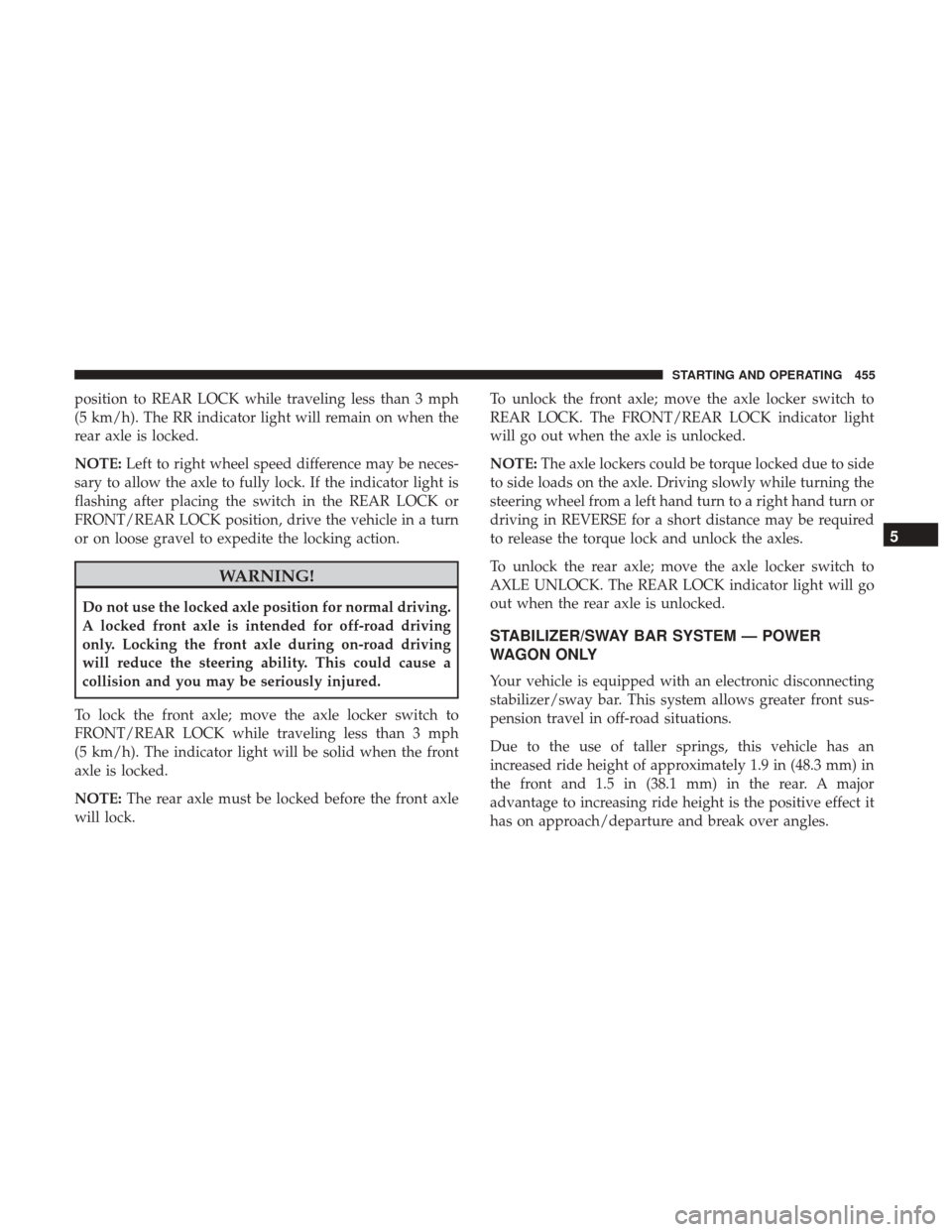
position to REAR LOCK while traveling less than 3 mph
(5 km/h). The RR indicator light will remain on when the
rear axle is locked.
NOTE:Left to right wheel speed difference may be neces-
sary to allow the axle to fully lock. If the indicator light is
flashing after placing the switch in the REAR LOCK or
FRONT/REAR LOCK position, drive the vehicle in a turn
or on loose gravel to expedite the locking action.
WARNING!
Do not use the locked axle position for normal driving.
A locked front axle is intended for off-road driving
only. Locking the front axle during on-road driving
will reduce the steering ability. This could cause a
collision and you may be seriously injured.
To lock the front axle; move the axle locker switch to
FRONT/REAR LOCK while traveling less than 3 mph
(5 km/h). The indicator light will be solid when the front
axle is locked.
NOTE: The rear axle must be locked before the front axle
will lock. To unlock the front axle; move the axle locker switch to
REAR LOCK. The FRONT/REAR LOCK indicator light
will go out when the axle is unlocked.
NOTE:
The axle lockers could be torque locked due to side
to side loads on the axle. Driving slowly while turning the
steering wheel from a left hand turn to a right hand turn or
driving in REVERSE for a short distance may be required
to release the torque lock and unlock the axles.
To unlock the rear axle; move the axle locker switch to
AXLE UNLOCK. The REAR LOCK indicator light will go
out when the rear axle is unlocked.
STABILIZER/SWAY BAR SYSTEM — POWER
WAGON ONLY
Your vehicle is equipped with an electronic disconnecting
stabilizer/sway bar. This system allows greater front sus-
pension travel in off-road situations.
Due to the use of taller springs, this vehicle has an
increased ride height of approximately 1.9 in (48.3 mm) in
the front and 1.5 in (38.1 mm) in the rear. A major
advantage to increasing ride height is the positive effect it
has on approach/departure and break over angles.
5
STARTING AND OPERATING 455
Page 458 of 734

This system is controlled by the electronic control sway bar
switch located on the instrument panel.
The switch has two positions; On-Road and Off-Road. The
system is normally in the On-Road mode, indicated by a
solid green light. The stabilizer/sway bar should remain in
the On-Road mode during normal driving conditions.WARNING!
Do not disconnect the stabilizer bar and drive on hard
surfaced roads or at speeds above 18 mph (29 km/h),
you may lose control of the vehicle, which could result
in serious injury or death. The front stabilizer bar
enhances vehicle stability and assists in maintaining
control of the vehicle. The system monitors vehicle
speed and will attempt to reconnect the stabilizer bar
at speeds over 18 mph (29 km/h). This is indicated by a
flashing off road light and solid on road light. Once
vehicle speed is reduced below 14 mph (22 km/h), the
system will attempt to return to the Off-Road mode.
To disconnect the stabilizer/sway bar, shift to either 4HI or
4LO as shown in “Four Wheel Drive Operation” and push
the right hand Off Road stabilizer/sway bar button to
obtain the Off-Road position. The amber indicator light
will flash until the stabilizer/sway bar has been fully
disconnected.
Sway Bar Disconnect Buttons
456 STARTING AND OPERATING
Page 459 of 734
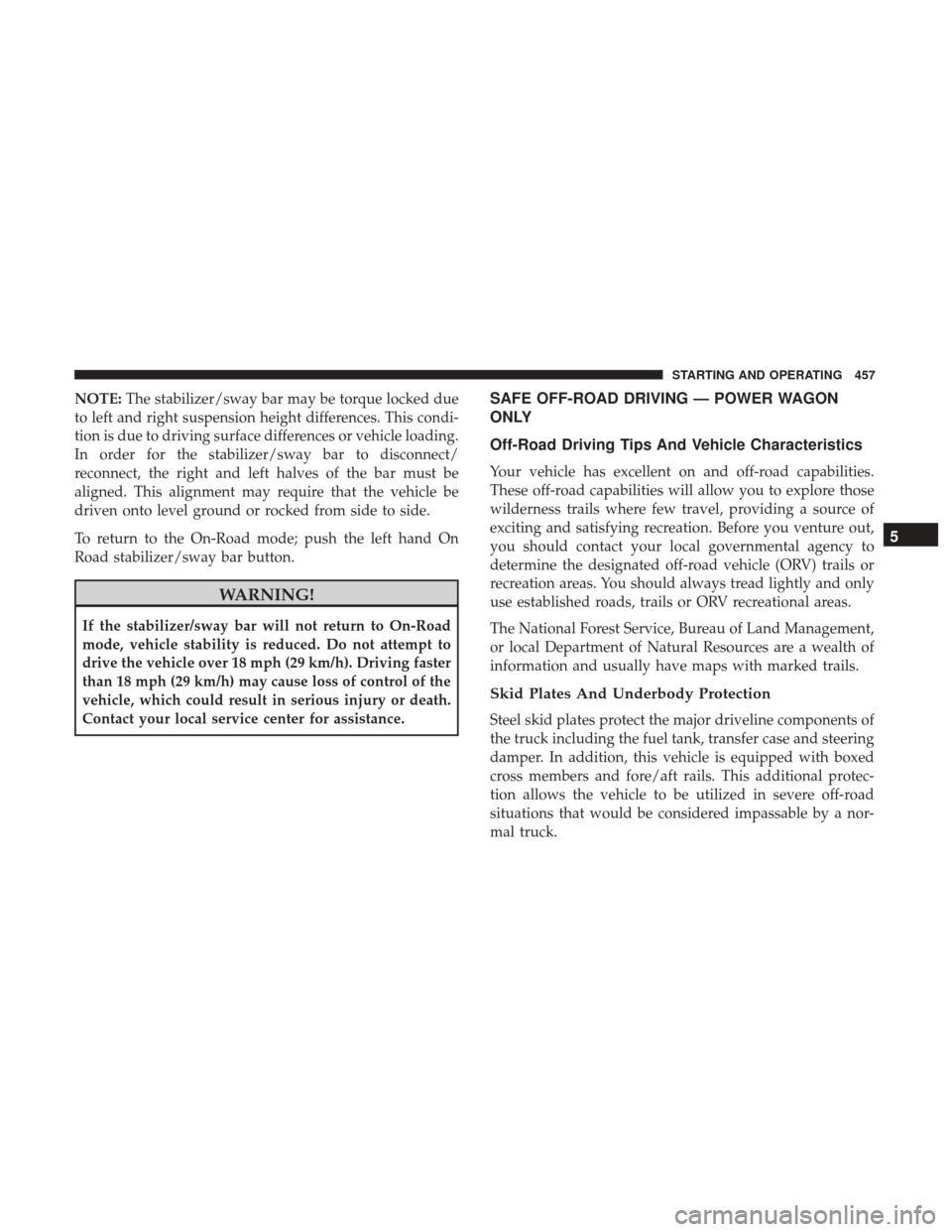
NOTE:The stabilizer/sway bar may be torque locked due
to left and right suspension height differences. This condi-
tion is due to driving surface differences or vehicle loading.
In order for the stabilizer/sway bar to disconnect/
reconnect, the right and left halves of the bar must be
aligned. This alignment may require that the vehicle be
driven onto level ground or rocked from side to side.
To return to the On-Road mode; push the left hand On
Road stabilizer/sway bar button.
WARNING!
If the stabilizer/sway bar will not return to On-Road
mode, vehicle stability is reduced. Do not attempt to
drive the vehicle over 18 mph (29 km/h). Driving faster
than 18 mph (29 km/h) may cause loss of control of the
vehicle, which could result in serious injury or death.
Contact your local service center for assistance.
SAFE OFF-ROAD DRIVING — POWER WAGON
ONLY
Off-Road Driving Tips And Vehicle Characteristics
Your vehicle has excellent on and off-road capabilities.
These off-road capabilities will allow you to explore those
wilderness trails where few travel, providing a source of
exciting and satisfying recreation. Before you venture out,
you should contact your local governmental agency to
determine the designated off-road vehicle (ORV) trails or
recreation areas. You should always tread lightly and only
use established roads, trails or ORV recreational areas.
The National Forest Service, Bureau of Land Management,
or local Department of Natural Resources are a wealth of
information and usually have maps with marked trails.
Skid Plates And Underbody Protection
Steel skid plates protect the major driveline components of
the truck including the fuel tank, transfer case and steering
damper. In addition, this vehicle is equipped with boxed
cross members and fore/aft rails. This additional protec-
tion allows the vehicle to be utilized in severe off-road
situations that would be considered impassable by a nor-
mal truck.
5
STARTING AND OPERATING 457
Page 460 of 734

Ramp Travel Index (RTI)
The ramp travel index is the distance, in inches, that you
can drive your vehicle with one wheel on a 20-degree ramp
without lifting any other wheel off the ground. This
distance up the ramp divided by the wheelbase of the
vehicle and multiplied by 1,000 is the RTI. This vehicle has
an RTI of 510, which means you can articulate one front
wheel 26 inches (66 cm) in the air while the other three
wheels remain in contact with the ground.
Water Fording Characteristics
Water fording characteristic is the vehicle’s ability to cross
a body of still water, where the powertrain and drivetrain
are safe from water ingestion. This vehicle has high water
fording characteristics with the ability to cross a pool of
water, without stopping, 24 inches (60 cm) deep at a
maximum speed of 10 mph (16 km/h) and a pool of water
30 inches (76 cm) deep at a maximum speed of 5 mph
(8 km/h), both with an entrance ramp angle of 1.3 degrees.
CAUTION!
The door sill height is 25 inches (63.5 cm). Water may
intrude into the interior of the vehicle at greater
depths.
Simultaneous Brake And Throttle Operation
Many off-road driving conditions require the simultaneous
use of the brake and throttle (two footed driving). When
climbing rocks, logs, or other stepped objects, using light
brake pressure with light throttle will keep the vehicle from
jerking or lurching. This technique is also used when you
need to stop and restart a vehicle on a steep incline.
The Basics Of Off-Road Driving
You will encounter many types of terrain driving off-road.
You should be familiar with the terrain and area before
proceeding. There are many types of surface conditions: hard
packed dirt, gravel, rocks, grass, sand, mud, snow and ice.
Every surface has a different effect on your vehicle’s steering,
handling and traction. Controlling your vehicle is one of the
keys to successful off-road driving, so always keep a firm
grip on the steering wheel and maintain a good driving
posture. Avoid sudden accelerations, turns or braking. In
most cases there are no road signs, posted speed limits or
signal lights. Therefore you will need to use your own good
judgment on what is safe and what isn’t. When on a trail you
should always be looking ahead for surface obstacles and
changes in terrain. The key is to plan your future driving
route while remembering what you are currently driving
over.
458 STARTING AND OPERATING